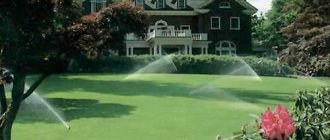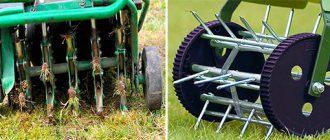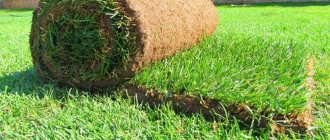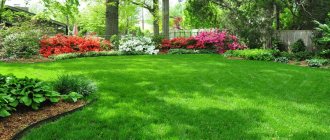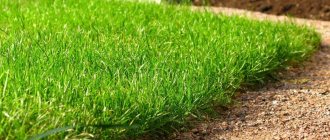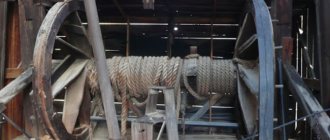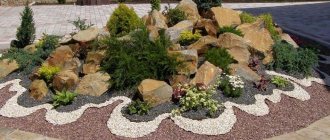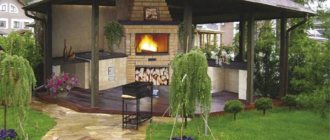Garden care
A beautiful, well-groomed and soft lawn is the real pride of summer residents. A smooth surface and rich green shades will decorate the area, harmoniously complementing it. To achieve an ideal result, it is necessary to provide the grass with proper care. In addition to regular watering and mowing, it is also necessary to ventilate the planted grass. In this article we will tell you how to aerate a lawn with your own hands, consider the features of this procedure, as well as the tools that will be needed during the work process.
- 1 Why do you need lawn aeration?
- 2 When to aerate your lawn yourself?
- 3 How to aerate a lawn with your own hands
- 4 How to pierce the lawn for ventilation
Why do you need lawn aeration?
Before you aerate your lawn, you need to understand why this procedure is needed. Literally, the concept of “aeration” means “to ventilate.” In scientific terms, this is a process that improves gas exchange between oxygen and ground air.
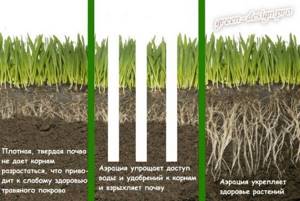
Without aeration, grass wilts. This allows weeds and various diseases to spread throughout the lawn.
Lawn turf often has areas of very compacted and hard soil. Because of this phenomenon, the process of moisture supply to the grass root system deteriorates, and nutrients also flow more slowly. In parallel with this, carbon dioxide accumulates, which slows down grass growth. Without regular scarification, harmful consequences may occur:
- the appearance of the grass will deteriorate, foreign plants, moss, and dry bald spots will be observed in the area;
- beautiful grass will be less resistant to moisture and cold temperatures.
You can solve this situation yourself if you know how to aerate a lawn with your own hands. The process of ventilation involves piercing the soil so that through the holes it is possible to increase the access of oxygen and moisture. The advantage of the procedure is that there is no need to carry it out over the entire territory at once; it is enough to do it only in problem areas. For example, where children often play, or fungal diseases have been noticed.
More information about the garden lawn can be found in our article “The lawn is an essential attribute of your garden”
When to aerate your lawn yourself?
The first thing that interests gardeners who have not previously encountered such a procedure is when is the best time to engage in the process of turf aeration . The optimal indicator is to perform the lawn aeration procedure twice during the season. But at the same time, the climatic features of the territory, the varieties of plants planted on the site, and the load to which the grass is exposed must be taken into account. Based on these factors, it is determined how often to scarify the lawn soil:
- sports types of turf that are exposed to high levels of stress require the procedure to be performed twice or thrice a year;
- unfavorable climatic conditions (frequent rains, for example) require an additional ventilation process;
- If you find areas with moss or yellowed grass on the territory, you will need to carry out immediate ventilation.
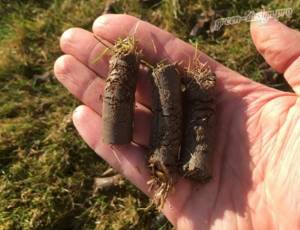
Sandy soil requires a one-time procedure, and clay soil requires a 2-3-fold process, since such soil is subject to more pressing compared to other methods.
Note! When fescue and bluegrass grow on the territory, the area can be ventilated only in the autumn. These types of crops are late season varieties. For Bermuda grass or any other heat-loving representative, the procedure is important at the end of the spring season - at the beginning of the summer.
To determine the need for ventilation, use the following method:
- Take out a small garden trowel and use it to cut out a piece of soil with lawn grass;
- Carefully inspect the roots of the lawn grass.
If the root system is small (up to 5 cm in length), this means that urgent ventilation will be needed, since the plants do not receive the required amount of oxygen.
You will learn more about choosing lawn grass for the garden in our article “Lawn grass: how and when to plant and how to care for the lawn“
How to choose an aerator: selection criteria
When purchasing an aerator, you need to consider the following factors:
• functionality and technical characteristics of the device;
• correspondence between the power of the device and the area of the lawn;
• presence of a compartment for collecting grass;
• type of installed knives;
• processing width;
• features of equipment operation.
The higher the power of the aerator, the longer it can work without interruption. It will be extremely inconvenient to operate a low-power device over a large area. The wide working element will make it possible to treat the lawn in a short period of time.
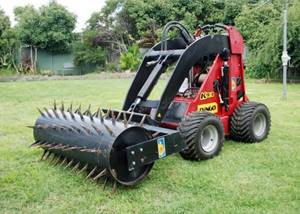
The grass catcher will also speed up the work, since after digging with the tool you will not have to rake and collect grass and debris. If the model is equipped with spokes, then the principle of processing is to pierce the soil. Aerators (scarifiers) equipped with knives are capable of removing weeds by trimming the root system, which prevents rapid growth. Such models can be used throughout the entire period of plant growth.
When choosing, you should also pay attention to the type of material from which the case is made. Models are available in plastic and metal. Each of them has its own advantages and disadvantages. For example, the plastic case is lightweight, which makes it easier to operate the equipment, and the metal, although susceptible to corrosion, resists mechanical stress much better. Here, each owner can decide based on his own wishes and preferences.
How to aerate your lawn yourself
When planning to ventilate the area, you need to thoroughly water the grass several days in advance to soften the soil. This will make it easier to pierce. If it rains, then the procedure is performed the next day. It is strictly forbidden to scarify and aerate the lawn during hot periods. This can lead to harmful consequences.
In large areas, a special device for aerating the lawn is usually used - a lawn verticulator with an electric or gasoline engine.
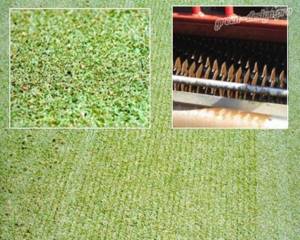
A verticulator is a device for aerating a lawn and the result of its work.
With its help, movements are performed that are reminiscent of the process of mowing grass. After a few days, the soil will dry out and will need to be leveled with a rake. After aerating the soil, you can fertilize it, and in problem areas you can sow greens.
We also note that there are 2 ways to carry out the process:
- Piercing. Using iron spikes, 4 cm depressions are formed in the ground. The method involves processing only felt deposits. The technique helps young grass grow faster without affecting the root system. The use of pricking is important on loose, well-drained soil.
- Piercing. The method is based on making 8-12 cm holes in the ground, affecting both the felt covering and compacting the ground. In this case, air penetrates into the cracks. The method is relevant for heavy soils.
The depth of lawn aeration depends on the chosen method and the condition of the soil.
More information about lawn care: https://www.green-design.pro/stati/uhod-za-sadom/10-sovetov-po-uhodu-za-gazonom/
Verticutter-aerator ZUBR ZSE-32-1000
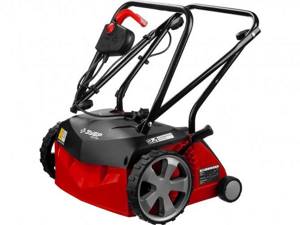
Photo: https://beru.ru
The model from ZUBR combines a modern design solution and ease of use. Shafts are easily replaced, allowing you to quickly move from one landscape task to another. Treatment of roots with moisture and oxygen is targeted, which allows maintaining the density of the green cover. The model is equipped with a motor with a power of 1000 W. The optimal processing width is 32 cm. This is possible with a large selection of modes and a stepped central system for their adjustment. The grass catcher has a capacity of 40 liters and can accommodate quite a lot of waste.
Verticutter-aerator ZUBR ZSE-32-1000
Advantages:
- spot tillage
- high performance
- Possibility of setting up the device and operating modes
- a wide range of tasks available to perform
- spacious characteristics of the grass catcher
Disadvantages: not found
How to pierce a lawn for ventilation
To perform the aeration process efficiently, you need to choose the right tool for aerating your lawn. You can purchase suitable devices, but you can also use improvised methods. For example, a fork or fan rake allows you to make high-quality punctures in the soil (up to 10 cm deep). But this method is relevant for small areas, since it is quite difficult to manually process large areas, and the process itself will take a lot of time.
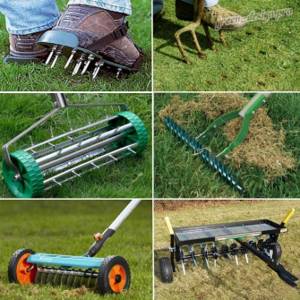
Various types of tools for aerating a garden lawn
A popular lawn aeration device is rake aerators. They do not have pins; in their place there are steel rods that are shaped like a sickle. Using this type of rake makes it easy to cut the soil horizontally and comb out dead grass that interferes with the supply of oxygen and moisture. You can purchase such a device at a gardening store.
Summer residents also prefer to buy special attachments for shoes to aerate the lawn. For example, special boots or sandals with vertical spikes on the soles are often found. The shoes are put on over the usual ones, after which the summer resident can simply walk on the lawn grass, carefully piercing it.
For large areas, it would be better to purchase special devices for treating grass. They can run on electricity or gasoline. When choosing, you should take into account financial capabilities and the size of the area with lawn grass.
Do-it-yourself lawn aeration is an important process in garden care. Proper execution of the procedure guarantees beautiful, healthy, green grass that can be enjoyed for many years.
Aerators on wheels
To make such a device you will need:
- a pipe with a diameter of at least 200 mm (a length of 1 m will be enough);
- nails 100 mm - 25-30 pieces (the number of nails can be adjusted independently depending on the diameter of the pipe);
- weighting materials (gravel, crushed stone, sand, screenings, cement mortar);
- structure consisting of a shaft and bearings;
- wooden handle (you can use a holder from a rake or shovel).
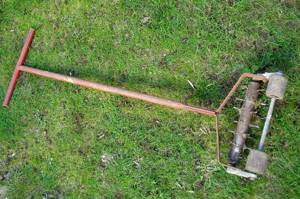
Nails are welded in a checkerboard pattern on the outside of the pipe using a welding machine. In order for the manufactured device to pierce the soil efficiently, it must be weighted, for which purpose the hollow space of the pipe is filled with weighting materials and the side holes are welded. The resulting structure is mounted on a shaft with bearings (you can do without them, but then working with the aerator will be much harder; the bearings will still ensure unhindered rotation of the pipe). The shaft is attached to a bracket with a handle; if you decide not to use a wooden holder as a manual control, but to weld a metal pipe, then use a diameter of at least 20 mm.
This DIY aerator on wheels will increase the speed of piercing lawn areas several times.
The design of this device can be mechanized, for which a shaft with a pipe and nails is fixed on a metal frame welded from a corner, and then the resulting device is connected to a mini-tractor. The result is a mechanical aerator; its performance can be increased by using a larger diameter pipe.
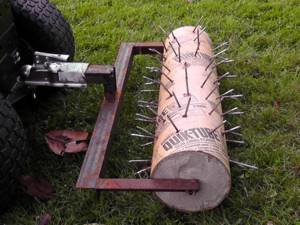
If you have an unnecessary axle with wheels lying around your household (for example, from an old wheelbarrow), and you have not yet found a use for it, you can use this thing to make an aerator. Tubes are attached to the inside of the wheels, parallel to the axle, onto which nails or pins are welded. The tubes must be positioned and secured in such a way that when the wheels move, the pins pierce the lawn. For ease of control, attach the handle to the shaft.
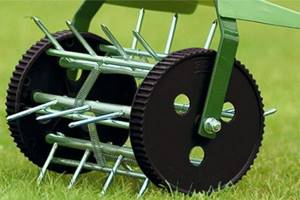
We hope that you will be able to choose the necessary option for a homemade aerator according to your technical abilities and the size of your lawn. Carry out the aeration procedure regularly (twice a season in moderate weather conditions will be enough) and, perhaps, your lawn will still compete with English ones.
